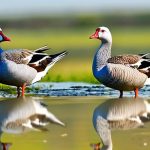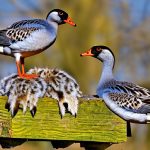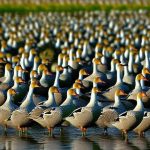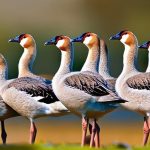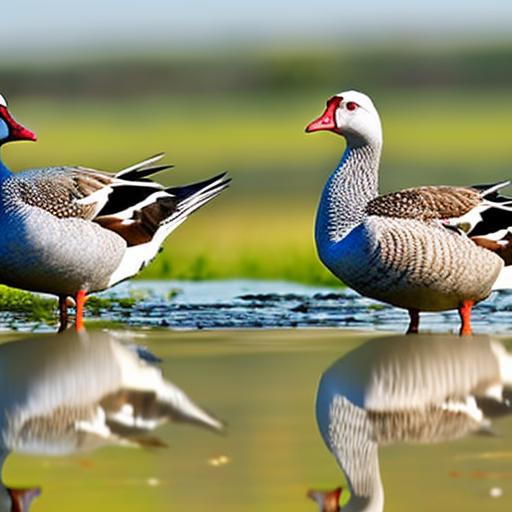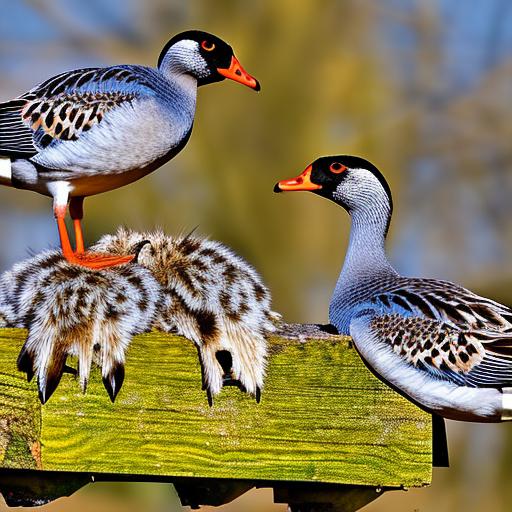The geese breeding season in South Africa is a time of great significance for both the geese themselves and the ecosystem as a whole. This period, which typically occurs during the spring and summer months, is marked by the mating, nesting, and hatching of goslings. It is a time of great activity and excitement as geese engage in elaborate mating rituals, build nests, and raise their young. The breeding season is a crucial time for the survival and continuation of the species, and it also plays a vital role in the overall health of the ecosystem. In this article, we will explore the various aspects of the geese breeding season in South Africa, including their migration patterns, nesting habits, threats they face, and conservation efforts to protect them. We will also delve into the spectacular display of geese mating rituals and the importance of the breeding season for South African wildlife tourism.
The Role of Geese in the Ecosystem
Geese play a crucial role in the ecosystem, particularly in wetland areas where they are commonly found. As herbivores, geese feed on a variety of plant species, including grasses, sedges, and aquatic vegetation. By doing so, they help to control the growth of these plants, preventing them from becoming overgrown and choking out other species. In addition, geese also contribute to nutrient cycling in wetland ecosystems through their droppings, which provide valuable nutrients for plants and other organisms. Furthermore, geese are an important food source for predators such as foxes, coyotes, and birds of prey, helping to maintain a balanced food web. Overall, geese play a vital role in maintaining the health and balance of wetland ecosystems, making their breeding season of great importance to the overall functioning of these habitats.
Migration Patterns and Nesting Habits of South African Geese
South African geese are known for their impressive migration patterns, with many species traveling long distances between their breeding and wintering grounds. Some species, such as the Egyptian goose, are resident breeders and do not migrate, while others, like the Spur-winged goose, undertake extensive migrations across the continent. During the breeding season, geese typically seek out suitable nesting sites near water bodies such as rivers, lakes, and wetlands. They build their nests on the ground using a variety of materials such as grasses, reeds, and twigs, often lining them with down feathers for insulation. Geese are known for their strong pair bonds and will often return to the same nesting site year after year. Once the eggs are laid, both parents take turns incubating them until they hatch, after which they care for and protect their young until they are old enough to fend for themselves.
Threats and Conservation Efforts for South African Geese
Despite their importance in the ecosystem, South African geese face a number of threats that put their survival at risk. Habitat loss and degradation due to human activities such as agriculture, urban development, and pollution are major threats to geese populations. In addition, hunting and poaching pose a significant threat to some species of geese, particularly those that are prized for their meat or feathers. Climate change is also a growing concern, as it can lead to changes in habitat availability and food sources for geese. To address these threats and protect South African geese, various conservation efforts are underway. These include the establishment of protected areas and wetland reserves, habitat restoration projects, and initiatives to reduce hunting pressure on vulnerable species. In addition, public awareness and education programs are being implemented to promote coexistence between humans and geese and to raise awareness about the importance of conserving these birds.
The Spectacular Display of Geese Mating Rituals
The geese breeding season is marked by spectacular displays of mating rituals that are both fascinating and beautiful to witness. Male geese often engage in elaborate courtship displays to attract females, which can include vocalizations, head bobbing, wing flapping, and other behaviors. Once a pair has formed, they engage in synchronized displays such as head dipping and neck stretching as a way of strengthening their bond. These displays not only serve to attract mates but also to establish and reinforce pair bonds between individuals. The sight of geese engaging in these intricate mating rituals is a testament to the strength and resilience of these birds and is a highlight of the breeding season for many wildlife enthusiasts.
The Importance of Geese Breeding Season for South African Wildlife Tourism
The geese breeding season holds great significance for South African wildlife tourism, attracting visitors from around the world who come to witness these magnificent birds in their natural habitat. Many wetland areas in South Africa are popular destinations for birdwatching and wildlife photography during the breeding season, offering opportunities to observe geese engaging in their mating rituals, nesting behaviors, and caring for their young. In addition to geese, these areas are home to a diverse array of bird species, mammals, reptiles, and amphibians, making them prime locations for ecotourism. The presence of geese during the breeding season adds to the overall appeal of these destinations and contributes to the local economy through tourism-related activities such as guided birdwatching tours, nature walks, and wildlife photography workshops.
Tips for Observing Geese Breeding Season in South Africa
For those interested in observing the geese breeding season in South Africa, there are several tips to keep in mind to ensure a rewarding experience while minimizing disturbance to the birds. First and foremost, it is important to respect wildlife and their habitats by observing from a distance and avoiding any actions that could disrupt their natural behaviors. When visiting wetland areas during the breeding season, it is advisable to stay on designated trails or viewing platforms to minimize trampling of vegetation and disturbance to nesting sites. Binoculars or a camera with a telephoto lens can be useful for observing geese from a distance without causing them stress. It is also important to be mindful of local regulations regarding wildlife viewing and to follow any guidelines provided by park authorities or tour operators. By following these tips and practicing responsible wildlife viewing ethics, visitors can enjoy a memorable experience while contributing to the conservation of South African geese and their habitats.
In conclusion, the geese breeding season in South Africa is a time of great significance for both the birds themselves and the ecosystem as a whole. From their vital role in maintaining wetland ecosystems to their spectacular mating rituals and importance for wildlife tourism, South African geese are truly remarkable creatures that deserve our attention and protection. By understanding their migration patterns, nesting habits, threats they face, and conservation efforts to protect them, we can work towards ensuring a bright future for these iconic birds. Whether observing them in their natural habitat or supporting conservation initiatives, there are many ways to appreciate and contribute to the preservation of South African geese during their breeding season.
Meet Walter, the feathered-friend fanatic of Florida! Nestled in the sunshine state, Walter struts through life with his feathered companions, clucking his way to happiness. With a coop that’s fancier than a five-star hotel, he’s the Don Juan of the chicken world. When he’s not teaching his hens to do the cha-cha, you’ll find him in a heated debate with his prized rooster, Sir Clucks-a-Lot. Walter’s poultry passion is no yolk; he’s the sunny-side-up guy you never knew you needed in your flock of friends!


